Erica Jurus's Blog, page 14
April 18, 2023
Spring blooms on earth and online
 A splendour of daffodils, my favourite flower, on a sunny Sunday at the Royal Botanical Gardens
A splendour of daffodils, my favourite flower, on a sunny Sunday at the Royal Botanical Gardens On a beautiful spring day, gardens are usually the best places to be, and plenty of people were proving that this past weekend at the Royal Botanical Gardens in Hamilton, Ontario. We were notified that, because of the unseasonable warm stretch we enjoyed for the better part of a week, the ornamental cherry trees and the magnolias in the Arboretum were blooming in full force. Neither of these flowers last very long, so the window to catch them is brief — almost impossible to plan a visit if you’re not within easy driving distance, but as my hubby and I are, we were able to make the pilgrimage.
To be honest, I prefer the cherry blossoms in the Niagara area, which are very pretty shades of pink, but the masses of pink-tinged white blossoms at the RBG are lovely as well.

Personally, I felt the magnolias stole the show, though. While they seem like a fragile flower, judging by how quickly they pass and fall off, apparently the magnolia is one of the oldest plant species existing today — they’ve been found in fossil records as far back as 100 million years ago. There are about 80 different species, and today they’re indigenous in only two places in the world, southern China and the southern U.S. Here in Ontario I think we’re the most northern spot where these warmer-zone plants will grow. There are a number of them on the street where I live, the typical small-tree version that’s ubiquitous in local yards, but the trees at the RBG towered over us, creating a dream-like canopy of lush white blooms.

But enough of the branches hung toward the ground with their heavy flowers to be able to see and sniff them close up, which many visitors took advantage of.

Something else has been blossoming over the past few days: my new Facebook page. I hope you’ll take the time to check it out and sign up to follow it for daily updates, news about the launch for Through the Monster-glass, sneak previews of the cover and more fun tidbits. I’m still getting it rolling, but if there’s anything you’d like to see on the page, do drop me a comment to let me know. Since the weekend I’ve been honouring Earth Week, leading up to Earth Day on April 22, with photos of some of the many beautiful things on our planet; I hope you enjoy them.
All photos were taken by me and all rights are reserved. E. Jurus
April 10, 2023
Fancy a little romance?
 (photo by E. Jurus, all rights reserved)
(photo by E. Jurus, all rights reserved)I’m doing this week’s post a day early because I’m sharing a time-sensitive deal for anyone who might want to try their hand at writing a Romance novel: a bundle of tools, resources and training by The Romance Writer’s Super Stack that expires 11:59pm PST tomorrow, April 11th.
The package is one heck of a deal: three masterclasses, four story-crafting e-courses, ten e-books, a couple of planners, and quite a bit more, all for the great price of $49. That’s not a lot to shell out to learn how to do it well.
In case you’re scoffing, don’t – Romance is one of the highest-earning genres of fiction, bringing in over one billion dollars in revenue each year.
Most books have some form of relationship in them. What exactly makes a novel ‘romance’? Here are the defining elements:
The main plot is about the development of a romantic relationship between two people. The novel must have what’s called an “emotional throughline”, i.e. a connecting theme that plays out from start to finish.The story arc must build to an optimistic ending.If you’ve ever watched a Hallmark movie, you’ve seen all that in action. The ending is a foregone conclusion – what makes the stories interesting is how the happy couple get together, through various trials and tribulations and plot twists, and settings from cozy to exotic that are conducive to how the pair meet in the first place.
Beyond those, there are several plot mainstays that all romance readers expect from their experience.
For one, readers want to read about an experience they’d like to have themselves. Romance novels remind us of what it’s like to go through that first exciting flush of love.The novels are generally told through the woman’s perspective.
Today’s protagonists tend to be smart, strong-willed women, not the helpless females of earlier decades.
There’s always a conflict that needs to be overcome. Although that might sound too cheesy, if the course of true love ran straight there wouldn’t be much of a story to tell.
Like all fiction genres, there are a number of sub-genres within the Romance category:
Historical Romance. This includes any novel set before 1945, i.e. before the end of World War II (I’m not sure why that’s the cut-off point).Contemporary Romance. Apparently the social mores of all the years after the end of World War II are lumped under the word ‘contemporary’. Again, not sure why, as mores have changed dramatically within that time period, but there it is.Paranormal Romance. These novels combine a love story with fantastic or paranormal elements. I’ve read some terrific books in this category – the paranormal element offers some really interesting twists to the whole relationship. Fantasy Romance & Sci-Fi Romance. Generally, romance set in an alternate world/time, though not to be confused with…Time-travel Romance, where the lovers are from different times and somehow manage to meet across the years, decades or centuries. The Outlander novels would fall in this category.Romantic Suspense. Adding an element of mystery or suspense, with a puzzle for the romantic couple to solve. One of them is often in a legal type of job and helping out the other.Young Adult. Centering on the lives of young people, of course, with all the emotions and decision-making that goes with that period in our lives.Multicultural Romance. These novels explore love between interracial couples – less of an issue in modern times, one might hope, but not always.Inspirational Romance. Stories in which religious or spiritual beliefs impact the central love story. The relationship progresses in a more chaste way, and there is little to no bad language or violence. These contrast considerably from…Erotic Romance. There’s strong sexual content in these novels, usually fairly explicit. While other genres of Romance may feature what’s called sex “behind closed doors”, i.e. we see the build-up, but not the details of the actual act, erotic novels – like the Fifty Shades series – throw the door wide open. If you’re of a mind to write this kind of novel, do your research on how to write the sex scenes effectively. Diana Gabaldon, author of the Outlander novels, even wrote a how-to book, “I Give You My Body . . .”: How I Write Sex Scenes .As you can see, there’s a style of Romance for just about anyone, but it’s not as easy to produce as you might think. However, there’s a lot of material online that you can use for research, and a great place to start would be the Superstack bundle mentioned at the start of this post. (Please note that I do not have an affiliate website and get no reimbursement for passing on this type of information.)
One final thought: although writing Romance isn’t something I’ve ever thought of doing, I’d suggest that you should have fun doing it, which will infuse itself into your writing so that your readers will have as much fun when they buy the book.
N.B. I’ve installed a new Theme (WordPress style) and am having some technical issues — hopefully they’ll be resolved soon.
April 4, 2023
Method Writing – is it like Method Acting?
 Photo of a lovely, creepy-looking wooded area I took last week. By E Jurus, all rights reserved
Photo of a lovely, creepy-looking wooded area I took last week. By E Jurus, all rights reservedHave you ever battled a dragon? Or a demon? Or performed a ritual to place a hex on someone? (If you say ‘yes’ to the last one, I don’t want to know.)
One of the oft-spouted maxims of writing novels is ‘Write what you know’. For science fiction and fantasy writers, that’s often impossible, because making things up – ‘speculating’, if you want the more highbrow term – is our job.
That’s not to say that we can’t incorporate a lot of our life experience anyway – personality types we’ve encountered, geography we’ve explored that we turn into a great setting for a scene, the way we react to situations, aromas, tastes, sounds. But as much as we might yearn to, the reality is we’re never going to be able to walk in the worlds of our heroines and heroes.
The same is true for romance writers, thriller writers, adventure writers… We just do our best to get into the heads of our characters.
And so do actors. Some performers go to extreme lengths to understand what their character is feeling, to provide that unmistakable sheen of authenticity to a role. This is called ‘method’ acting, and while it’s created some remarkable performances on screen, it’s often controversial as well.
Robert DeNiro prepped for his role as the crazed Travis Bickle in Taxi Driver by actually tooting around as a cab driver in New York for nights on end without sleep. Not overly extreme, and the resulting performance earned him a nomination for best actor.
One of the most famous examples of method acting is Heath Ledger’s incredible transformation into the completely psychotic Joker in The Dark Knight (2008). I first remember Ledger playing cute surfer-boy types in movies like Ten Things I Hate About You, so to watch him become unrecognizable as the Joker was stunning. And perhaps the best part of his performance was his addition of enough comedy, twisted as it was, to give the character some depth. In order to put himself inside the body and mind of the Joker, he sequestered himself inside a hotel room and messed with his own head, altered his voice so much that he had to keep licking his dried-out lips (which the producers kept as a very effective quirk of the character), and performed damaging stunts to provide authenticity to some of the violence.
The downside of all of this obsessive immersion is that he suffered from insomnia and exhaustion. And in the end it may be what killed him, after he accidentally overdosed on sleeping medication. You can’t argue with the incredibly unsettling performance he gave in the role, but he didn’t live to see the accolades.
So there can be a price to overdoing a quest for authenticity, and I’d say that goes as much for writers as actors. I’ve often wondered how people who write very gory horror, or write about serial killers, go to sleep at night. From personal experience, it’s challenging to write a very powerful scene because you’re living it with the characters, and hard to get it out of your head afterward. I have no desire to put myself into the mind of a psychotic killer for a while.
But that’s me. Some very successful writers have done just that.
A number of famous writers have undergone substance abuse during the course of their work. Stephen King is a superstar in the novel world, but he paid a steep price to get there, abusing everything from NyQuil, alcohol and cigarettes to both prescription and mind-altering drugs. Apparently he later said, after his family’s intervention in the 1980s, that he didn’t even remember writing some of his raft of horror novels. He made good use of some of his worst moments and emotions, though.
Ernest Hemingway famously suffered from depression, and became an alcoholic to cope. While a lot of people revere one of his earliest novels, A Moveable Feast, about his time in Paris, I found it very melancholy. One of his most famous quotes was “Writing, at its best, is a lonely life.”
An article on the Writers Write website, Why Method Writing Makes You A Better Author, offers some suggestions on how to get into the headspace of a character you’ve never actually been, including a psychopath: “…remember a time when you were pushed to act in an amoral way. Use those feelings (or lack of them) to help you construct your character.”
I had enormous guilt about putting our beloved dogs to sleep when they became old and too sick to go on, even though I knew it was the kindest thing to do, so thinking like a psychopath would be very difficult for me, and frankly I’m glad of it. Nevertheless, when I was still suffering from chronic migraines, there were days when I was in so much pain that I felt as if I’d happily vampire-bite the first person who aggravated me too much and got within reach, and that feeling of having a flip side gave me the idea for the opening line in my first novel (sneak peek to come as I get the novel ready for publication!).
I like the fun side of striving for authenticity. There’s a very entertaining scene in one of my favourite series, Castle: Season 2 Episode 12, “A Rose for Everafter”, wherein, in order to figure out how his protagonist Nikki Heat would escape from the same situation, Rick Castle has his daughter Alexis duct-tape him to a chair, sealing his mouth as well. She and her grandmother then leave him to his own devices as he tips himself over and tries to retrieve various household items to cut himself free.
That’s ‘method writing’, and as I discovered with some research, a whole subset of the very large community of writers around the world who devote themselves to it. I’ve actually been to most of the locations in my first novel, so I can portray their flavour accurately. Since significant parts of my novels take place in the woods surrounding a small town in Ontario, my hubby and I have made many hiking expeditions talking about what would make a great backdrop for a scene. I also take a lot of photos, some of which I sell on Fine Art America, and have turned several of them into souvenir bookmarks for my upcoming Book Launch Party (more news on that to come as well – so much prep to do).
So while you have fun researching ways to give your writing the nuances that make it resonate with readers, bear in mind some cautions in a blog post, Method Writing – What, Why, and How, by Arc Studio, a website for screenwriters about using method writing safely, including avoiding burnout and taking some mental health breaks if you need to.
You can watch the Castle scene on YouTube for some inspiration and chuckles.
March 28, 2023
Colours, glorious colours
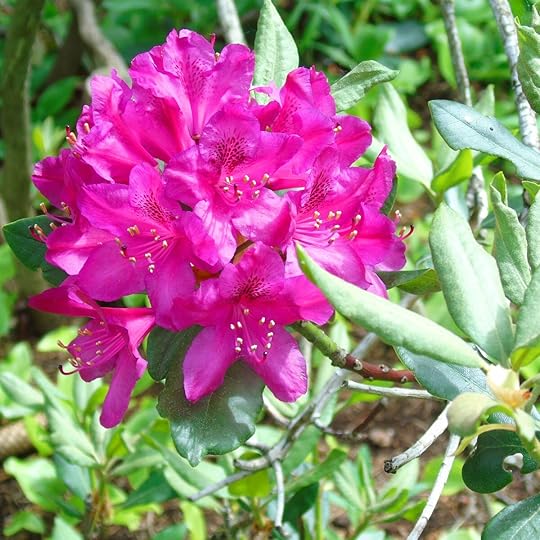
 Magenta tones in a lush rhododendron blossom; purple fringed tulips with shades of magenta — photos by E. Jurus, all rights reserved
Magenta tones in a lush rhododendron blossom; purple fringed tulips with shades of magenta — photos by E. Jurus, all rights reservedAre you a fan of magenta, aka fuchsia? It’s a striking purplish/reddish pink, a strong colour that I suspect invokes strong feelings in many of us. But this year, Pantone® Color Systems has named it their Color of the Year.

If you’re not a graphic designer, fashion designer or other kind of artist, you may wonder who the heck Pantone® is and who are they to arbitrarily designate an official colour. (By the way, my use of two spellings for the same word reflect Canadian ‘colour’ vs. American ‘color’, no typos involved).
So far on this blog we’ve looked at several different colours and the many variations that authors and artists throughout time have used to portray mood, culture and even status. Some of the colours have become historically famous and significant, like Royal Purple and Nile Green. But how were these colours reproduced reliably, and who came up with the names of them in the first place?
People from all walks of life have studied colours, and created colour systems that have defined colour values (the combinations of our primary colours: red, green and blue used to make each colour) much as dictionaries have codified what different words mean so that they’re used consistently and our languages don’t turn into verbal anarchy (or gibberish, as with the Biblical story of the Tower of Babel).
Pantone® is the authoritative colour system of the modern era. It was created in in the 1960s by a chemist, Lawrence Herbert, working for an advertising company, produced a colour-matching system that simplified the process for stocking color pigments. He eventually bought the struggling company and turned his system into its product. Starting with 500 colours in a flipbook of swatches. The flipbook is still used today, but has grown to 2,390 colours in several different formats. I myself still have a Pantone® swatch book from when I was a freelance graphic designer.
 Screenshot from the Pantone® website illustrating the colour flipbook; https://www.pantone.com/color-tools/physical-color-tools/graphics
Screenshot from the Pantone® website illustrating the colour flipbook; https://www.pantone.com/color-tools/physical-color-tools/graphics Graphic designers use Pantone values for both printed and web applications (for the Web, colours are given a “HEX” value to make sure they’ll show properly on a computer screen. (The HEX value for Viva Magenta, i.e. the value entered into the HTML code on a website, is #BE3455.)Today, many of the world’s nations even rely on the Pantone system to display the right colors on their flags. Pretty much anyone who works with colour uses Pantone values.
Why are we so obsessed with colour?
Colour gives our world richness, and conveys anything from great beauty to great horror. We can relate to the bright yellow of spring daffodils and the bronze of fall leaves. If someone mentions a cheeseburger, we’ll immediately picture gooey, delicious orangeness melting down the sides of a beef patty. Grey represents rainy days, thick fog, a river under an overcast sky.
Writers rarely wax poetic about the colours of things in their stories – we don’t want to mire our readers down in descriptions – but we do want to communicate a mental image. A mystery/horror/vampire writer will at some point need to describe a bloody scene, and sci-fi movies often use colours to portray alienness. Picture the lurid crimson of The Blob (1958), the virulent green of the lethal alien microbe in The Andromeda Strain (1971), even a magenta hue used to represent the alien Color Out of Space in the 2019 film with Nicolas Cage.
That movie was an adaptation of the 1927 H. P. Lovecraft short story The Colour Out of Space. In the story, the colour emanated from a strange meteor that had fallen on a small, remote community in the creepy fictional locale of Arkham. Lovecraft described it like this: “The colour, which resembled some of the bands in the meteor’s strange spectrum, was almost impossible to describe; and it was only by analogy that they called it colour at all.” For the movie, magenta was chosen because of its ‘extra-spectral status’, which means that it’s not a colour created when white light is broken down into its different wavelengths, each of which has a certain colour.
Colours are what we ‘see’ when waves of light pass into our eye and are picked up by specialized cells in our retinas called rod and cone cells. These cells transmit the information through the optic nerve to our brain. You can see all the spectral colours – red, orange, yellow, green, blue, indigo and violet, in that order – in a rainbow. All other colours are created by mixing spectral colours together. There’s even a strange category of ‘impossible’ colours that can’t been seen under normal viewings of light – we humans can only see them when we trick our eyes. (More on this subject in a future post.)
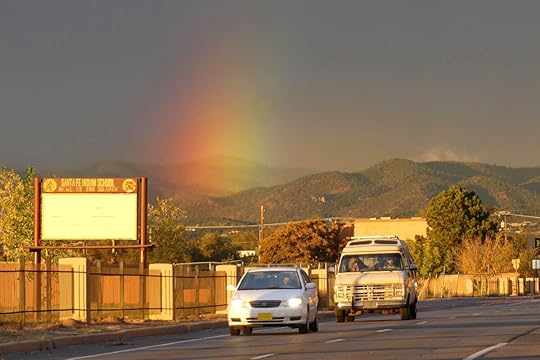 A very large and bright rainbow over Santa Fe, New Mexico — photo by E. Jurus, all rights reserved
A very large and bright rainbow over Santa Fe, New Mexico — photo by E. Jurus, all rights reservedSo what’s with the Magenta? I have to admit, it’s not one of my personal favourites, but it’s a good colour for Spring – it can be found in all kinds of flowers right from Mother Nature’s paint brush.
But it doesn’t have a wavelength. We see it as a colour because our brain fills in information in spots where it can’t make sense of something (not just with colours, but many other types of information). The space between red and purple needs to look like something, so our brain discusses amongst itself and offers up magenta. While that’s a biological technicality, we can reproduce magenta, as well as all colours not part of the visual spectrum, whenever we want, so in that sense our ingenuity trumps Nature.
And we can thank numerous colour classification systems for that, as well as what to call all the different colours.
Aristotle, the ancient Greek philosopher, was also a polymath – someone whose knowledge base spans a wide variety of subjects – and he covered everything from economics and government to drama, psychology and several sciences. Basically, he was interested in pretty much everything, and developed the first known theory of colour, which he believed came from white and black. Aristotle related colours to the four elements (air, earth, fire and water), and it wasn’t until the mid-1600s when the English physicist and mathematician Isaac Newton was able to demonstrate, with prisms and refraction, not only that white light was composed of seven colours, but that those colours could then be combined back into white light once more. His work led to breakthroughs in optics, chemistry and physics, and the study of color in nature.
…if the Sun’s Light consisted of but one sort of Rays, there would be but one Colour in the whole World…
–Sir Isaac Newton, Opticks
Newton’s innovations were challenged by none other than Johann Wolfgang von Goethe, the German poet and writer so famous that he became known by his last name alone (there’s even a statue of him in Vienna, made of bronze and coated in verdigris except for his toe, which remains shiny from all his modern admirers rubbing it). Goethe, quite a prolific thinker and very interesting character himself, was also a scientist, and in 1810 published his Theory of Colours, which he believed, out of all his famous writings, was his most important. Using his gift for poetry, he described colour as “light’s suffering and joy”
Jacob Christoph Le Blon was a painter and engraver from Frankfurt who invented the system of three- and four-colour printing, based on the three primary colours – red, yellow and blue and applied in layers via stippled metal plates (a method called mezzotint) that provided rich tones and great depth. His system eventually evolved into the colour printing technology we use today.
 A page from Le Blon’s 1725 Coloritto describing his RYB three-color printing process; By Jacob Christoph Le Blon – The Science of Color, reprint of page of Coloritto, Public Domain, https://commons.wikimedia.org/w/index.php?curid=3884858
A page from Le Blon’s 1725 Coloritto describing his RYB three-color printing process; By Jacob Christoph Le Blon – The Science of Color, reprint of page of Coloritto, Public Domain, https://commons.wikimedia.org/w/index.php?curid=3884858In 1686, a man named Richard Waller, a Fellow of the Royal Society of London, created one of the earliest known color charts as a tool by which scientists and collectors could describe their animal and plant specimens. Today we rather take for granted botanical gardens and zoos that acquaint us with many of the thousands of species in the world, but in the 17th to 19th centuries all of those species still had to be discovered, identified and catalogued. The intrepid researchers could compare their specimens to Waller’s chart and use the names provided to identify the colors of what they’d collected.
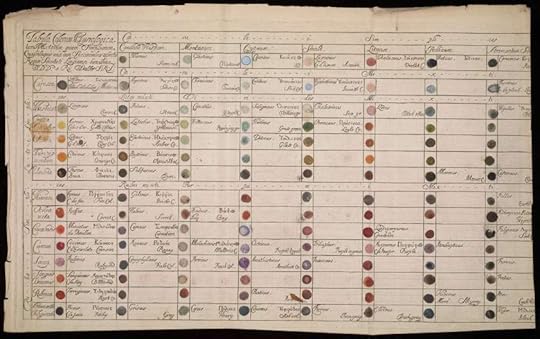 Richard Waller, Tabula colorum physiologica … [Table of physiological colors], Philosophical Transactions of the Royal Society of London, 1686; https://library.si.edu/exhibition/color-in-a-new-light/matching
Richard Waller, Tabula colorum physiologica … [Table of physiological colors], Philosophical Transactions of the Royal Society of London, 1686; https://library.si.edu/exhibition/color-in-a-new-light/matchingIt was in the late 1800s and early 1900s that the dedication of men from two very different fields combined to produce the colour-defining system that eventually became the Pantone® powerhouse. Milton Bradley – yes, the famous board-game fellow – learned lithography and set up his own colour printing shop in Massachusetts. He had an idea for a board game that he called The Checkered Game of Life, and after his printing business failed, he decided to try his hand at manufacturing games. His Game of Life was an instant success, and the rest is history. Bradley also manufactured crayons and watercolours, and was determined to find a reliable method for reproducing colours. He developed a ‘color wheel’: a device with overlapping coloured disks that could be spun to mix colours for the viewers. It was able to scientifically match and measure colors, creating a multitude of precise hues.
 The color wheel mechanism with two gears in the back and a blue, red, and yellow color wheel on the top. Data Source:
The color wheel mechanism with two gears in the back and a blue, red, and yellow color wheel on the top. Data Source:National Museum of American History, https://americanhistory.si.edu/collections/search/object/nmah_1184432
Bradley went even further, using his colour wheels, and a book called Elementary Color, as educational tools to teach both children and adults about both making colour and colour psychology, things he’d put to good use in building his extraordinarily successful company.
An ornithologist, Robert Ridgway, was the Smithsonian museum’s first curator of birds, and used colour as a way to help identify the thousands of bird species. Existing colour standards. which he found “vague and, for practical purposes, meaningless, thereby seriously impeding progress in almost every branch of industry and research”, used terminology like ‘zulu,’ ‘new old rose,’ and ‘London smoke,’ which were perhaps evocative but not quantifiable. Instead, Ridgway created his own color dictionary for naturalists in 1886, building on Bradley’s work. His contains 1,115 named colours, no mean feat.
Ridgway published Color Standards and Color Nomenclature himself in 1912, illustrated with 53 plates of painted samples. Great care was taken to maintain the consistency of colour reproduction and prevent fading. As a result, the book became a standard reference used by specialists in fields from ornithology to stamp collecting to food for decades after Ridgway’s death.
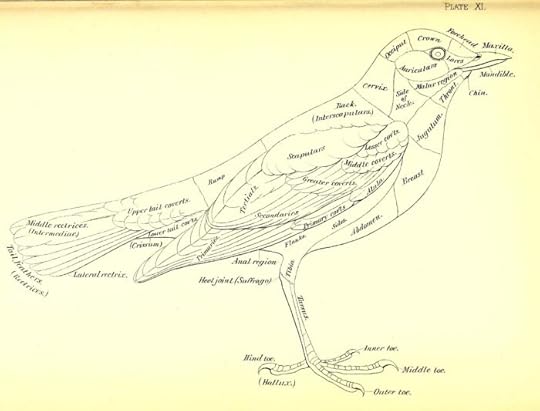 Ridgway’s bird diagram from his ‘A nomenclature of colors for naturalists : and compendium of useful knowledge for ornithologists’ (1886) gave precise indications of how to describe a specimen (via Smithsonian Libraries)
Ridgway’s bird diagram from his ‘A nomenclature of colors for naturalists : and compendium of useful knowledge for ornithologists’ (1886) gave precise indications of how to describe a specimen (via Smithsonian Libraries)Ridgway’s book eventually evolved into the Pantone color chart – and that divisive Magenta colour. Are you a fan of it, or not so much?
You may wonder why Pantone’s Color of the Year matters so much. Well, over the years, as the Pantone Color Institute studied colour trends throughout each year and how they related to all aspects of society – marketing, fashion, social media as it became mainstream, and even politics — the Color of the Year became more and more influential.
Today, hundreds of brands design products around the Color of the Year.
Spoonflower, one of my favourite places to browse cool wallpapers and fabrics for my dream house (for when I become the mega-successful author of my financial dreams), has for the past three years run a competition asking selected artists to create a design featuring the Color of the Year.
For the third year in a row, Spoonflower created a capsule collection with the Pantone color of the Year with contributions from six selected artists in its annual competition, selecting the winner with the most votes based on their designs incorporating Viva Magenta as the main color or central theme. These wallpapers are available for purchase while stocks last for anyone interested in incorporating Viva Magenta into their home decor.
 Screenshot of Spoonflower website highlighting designs using Viva Magenta; https://www.spoonflower.com/en/shop/viva-magenta
Screenshot of Spoonflower website highlighting designs using Viva Magenta; https://www.spoonflower.com/en/shop/viva-magenta For the first time, this year Motorola partnered with Pantone to launch the new Edge 30 Fusion phone in Viva Magenta.
 Screenshot of Motorola website highlighting new phone with Viva Magenta casing; https://www.motorola.com/us/smartphones-motorola-edge-30-fusion/p?skuId=850
Screenshot of Motorola website highlighting new phone with Viva Magenta casing; https://www.motorola.com/us/smartphones-motorola-edge-30-fusion/p?skuId=850 These businesses, as well as many others, are clearly capitalizing on the publicity to maximize their media coverage, but nevertheless the entire event has taken on a life of its own in our modern culture that embraces the ‘new and shiny’ syndrome.
Of course, colour psychology has been employed for years, if not millennia. There’s a reason that Royal Purple, extracted in precious and costly small quantities from Murex sea snails in ancient times, was chosen to symbolize the top tier of society. By the 9th century A.D., a child born to a reigning emperor was labelled as porphyrogenitos, or “born in the purple”. In England, Queen Elizabeth I forbade anyone except close members of the royal family to wear the colour purple. Although methods to synthetically produce the colour were developed in the 1800s, today the British Royal Family and other European royalty still use it as a ceremonial color on special occasions.
This blog has discussed how different colours can portray varying qualities and emotions. Most people find red very stimulating, for example, and it is of course the colour of love (although pink is used almost as much in Valentine’s Day flowers and media these days), but too much red can become unsettling, and some shades of red make us think of blood and horror. Orange is said to be a confident colour and to convey sociability, but once autumn rolls around it’s definitely the colour of that most sensory season. Most shades of orange are not as strident as red can be, and orange lights are easy on the eyes. Green symbolizes healing, freshness – all the qualities of Nature, while blue is supposed to represent trustworthiness and competence (hence the trend of navy blue ‘power’ suits for business dressing). Personally I find most shades of blue too cold-looking inside a house, and it’s not a good colour on me clothing-wise.
Pink, along with other soft colours, like pale yellow, robin’s egg blue, pale green, all signify babyhood, and Spring. They have a freshness that lightens the spirit. Personally I couldn’t live with them on a daily basis, but they’re nice on occasion. I came across this beautiful posting on the Williams Sonoma website the other day, and immediately printed the recipe to file for a future baking spree.
 Screenshot from Williams Sonoma home page; https://www.williams-sonoma.com/
Screenshot from Williams Sonoma home page; https://www.williams-sonoma.com/In classrooms, colour can be used to either encourage learning or taking relaxing breaks. Studies have shown that red, green and blue can create a sense of excitement in students, putting them in the right frame of mind for learning something new, while green, purple and certain shades of blue are conducive for rooms to have a nap break.
Colours are critical to how we make sense of the world. People with some form of colour-blindness can really struggle with interpreting their environment. Colours can give us great pleasure, when we look at stunning flowers or evocative paintings and photography. For writers, the psychology of colour is crucial in setting the tone of a character, or a scene, whether it’s a bright day at the beach or the menacing darkness inside a creepy house. We give thanks to the many colour-scientists who’ve created a systematized way for all artists to bring their ideas to life.
Feel free to ignore the Color of the Year if it doesn’t appeal to you. Everything we do in life should be based on our own preferences and lifestyle, not what others tell us we should like. The Pantone phenomenon just highlights how important colour is in our lives. Enjoy it as you prefer!
March 22, 2023
Did you/do you write letters?
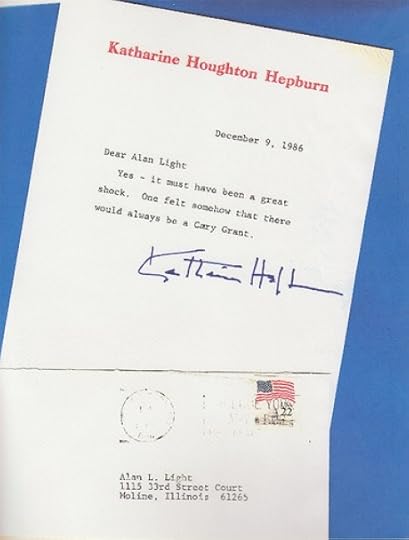 A thank-you letter from Katharine Hepburn to Alan Light thanking him for his condolences in regards of Cary Grant’s death – By from the Alan Light collection – https://www.flickr.com/photos/alan-light/2399093848/sizes/m/in/photostream/, Public Domain, https://commons.wikimedia.org/w/index.php?curid=102737701
A thank-you letter from Katharine Hepburn to Alan Light thanking him for his condolences in regards of Cary Grant’s death – By from the Alan Light collection – https://www.flickr.com/photos/alan-light/2399093848/sizes/m/in/photostream/, Public Domain, https://commons.wikimedia.org/w/index.php?curid=102737701You may find this paradoxical, but I’ve never been a good letter-writer. I just didn’t like the medium, which was in vogue when I was a child and teenager; once I sat down with pen and paper, my mind invariably went blank.
In those days, there didn’t seem to be much in my life that was interesting enough to put into a letter. On the phone with someone, you could riff off each other’s tidbits of information, and in my email correspondence with my brother there’s always something to chat about. There’s a give-and-take with both of those methods of communication that feels a lot more natural to me.
I even loved the process of writing by hand, in a nice cursive script that I developed from first grade onward. In Grade One I was the first student allowed to write in ink rather than pencil-lead because of my careful penmanship (that’s what teachers did in those days, as odd as that likely seems today). But as a way of sharing emotions with someone, or the trivia of day-to-day life, letters didn’t do it for me.
My mother was a long-time letter writer. She emigrated to Canada not long after the Second World War, and most of her family and friends were still in Europe, so she didn’t have a lot of choice if she wanted to keep in touch. Her oldest friend, a fellow nurse during the war, kept up a faithful correspondence with her for fifty years! After my dad passed away, my mom decided she wanted to take my hubby and me to Europe to show us places she’d lived, and we made a point of finding her friend’s home in a small village about half an hour outside Vienna, Austria so that they could see each other in person one more time. It was a remarkable journey.
What brought all this to mind was an article called Friday essay: a lament for the lost art of letter-writing – a radical art form reflecting ‘the full catastrophe of life’ in Conversation online magazine. The author lists very good reasons for why she loves the art of letter-writing, including the historical value of extant letters from history, although some of those missives are intimately personal, like those of James Joyce describing (for some reason) his wife’s farting.
He would have fit right into today’s era of far Too Much Information. Apparently the publication of Joyce’s letters were upsetting for his grandson, and I would have felt the same under the circumstances. And maybe that was the heart of why I never took to writing letters, apart from a handful my hubby and I. when we were still just dating, poured out to each other when he was out of town working for several months and we missed each other intensely. But I wouldn’t want to share them with anyone – they were something only for the eyes of the two of us.
I can’t imagine what inspired Joyce to wax explicit about how his wife passed gas – that’s not something that would ever occur to me for the subject of a letter. Perhaps with 10 siblings he became used to knowing the most intimate daily details of his large family. I’ve never read any of his writings and don’t have a good sense of his personality. But I assume that if one’s willing to commit something to paper (or email/text message), one’s comfortable with putting it out into the world.
On the other hand, people have gotten themselves into a great deal of trouble for just that, such as King Charles’ infamous letters to Camilla when he was still Prince of Wales and still married to Diana.
But I enjoyed reading the article and thought I’d pass it along. If you’re interested, you can read more about historically-famous letters here.
Were or are you a letter-writer? If so, what have you loved about it?
March 15, 2023
International Women’s Day and Nellie Bly
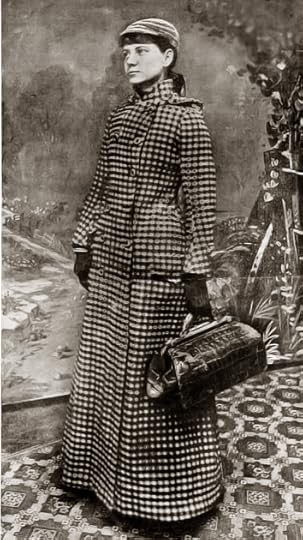 A publicity photograph taken by the New York World newspaper to promote Bly’s around-the-world voyage; by Historical and Public Figures Collection – New York Public Library Archives, http://digitalgallery.nypl.org/nypldigital/id?1121847, Public Domain, https://commons.wikimedia.org/w/index.php?curid=16259964
A publicity photograph taken by the New York World newspaper to promote Bly’s around-the-world voyage; by Historical and Public Figures Collection – New York Public Library Archives, http://digitalgallery.nypl.org/nypldigital/id?1121847, Public Domain, https://commons.wikimedia.org/w/index.php?curid=16259964My laptop has been fixed (problem with the charging port) and I though I’d post what I’d planned for last week, in celebration of the many great women throughout history – and in this case, a writer.
In the late 1800s, at a time when the majority of women had few options other than marriage while they were still young enough to be considered ‘marketable’, a gal named Nellie Bly made a name for herself as an intrepid journalist.
Along the way she not only arranged to have herself committed to an insane asylum for ten days to expose the appalling way that the poor patients were treated, but travelled by herself around the world in 72 days – not by the comforts of airplane, but by boat, horse, burro, rickshaw and an assortment of other methods few of us today will ever combine into a single journey.
(Just fyi, I myself have been on all of the above, but on very separate occasions. The burro is a long story.)
Elizabeth Cochran was born in 1864 in Pittsburgh, Pennsylvania. She studied to become a teacher, but had to drop out because of her family’s financial difficulties. She and her mother ran a boarding house together, until at the age of 18 she wrote a fiery anonymous rebuttal to a newspaper article she saw in the Pittsburgh Dispatch, wherein the writer asserted that women were only good for domestic duties and that working women were ‘monstrosities’. It’s sadly ironic that more than 150 years later the same opinion still exists in parts of the world.
The Dispatch’s publisher was impressed by what Elizabeth had written, and hired her to write for the paper. The tradition of the time was to write under a pen name, and she chose ‘Nellie Bly’, after a character in a popular 1850 song by Stephen Foster. She went on to make history under that name.
As a reporter for the Dispatch, Bly earned $5/week. She worked on exposing the poor treatment of women in society, and even posed as a sweatshop worker at one point. The factory owners began to complain about her articles, and the paper reassigned her to the ‘women’s pages’. But Nellie was determined “to do something no girl has done before”.
She went to Mexico to as a foreign correspondent, reporting on the lives of the people there, but once again her pioneering work brought her trouble. After protesting the imprisonment of a local journalist for criticizing the Mexican government, the Mexican authorities threatened her with arrest. She fled the country and published a book called Six Months in Mexico.
In 1887, looking for meatier assignments, she relocated to New York City and began working for the New York World.
One of her earliest assignments was to write an article about the experiences that inmates endured at an infamous mental institution on Blackwell’s Island (now Roosevelt Island) in New York. Bly pretended to be a mental patient in order to be committed to the facility. In the 10 days she stayed there, she discovered the horrors of the treatment of patients who, just by not fitting the accepted mold, were conveniently relegated to the asylum.
Blackwell’s was overcrowded, and so understaffed that there were only 16 doctors to see to over 1,600 patients. The doctors and other staff had little training and even less compassion, brutally taking their own character flaws out on their patients – ‘treatments’ that included forcing them to sit shivering in ice baths, or immobile for hours on a bench. Their food and living conditions were appalling, and any complaints were met with beatings and sexual abuse.
Asylums in general at the time were treated like entertainment venues, where the curious could go to observe the ‘mad’. Even worse, a lot of the inmates weren’t insane at all, just poor people with no family to turn to, or immigrants who couldn’t speak English. They suffered intense trauma from the ghastly things they went through at the hands of the staff.
Bly’s exposé became a sensation and had speedy results. Within a month, a grand-jury panel visited the asylum to investigate, and even though the hospital had been tipped off in advance and cleaned things up, the jury sided with Nellie and implemented important changes. Some of those changes included improvements to the assessment system so that people who didn’t have mental illness were no longer committed, the hiring of translators for different languages, and more funding for proper staffing.
In 1888 the newspaper gave Nellie the green light to attempt to recreate the scenario in Jules Verne’s famous novel, Around the World in 80 Days. She turned her experiences into another book, Around the World in Seventy-Two Days (1890).
Chapter One, titled “A Proposal to Girdle the Earth”, described how the idea for her adventure was generated:
W HAT gave me the idea?
It is sometimes difficult to tell exactly what gives birth to an idea. Ideas are the chief stock in trade of newspaper writers and generally they are the scarcest stock in market, but they do come occasionally,
This idea came to me one Sunday. I had spent a greater part of the day and half the night vainly trying to fasten on some idea for a newspaper article. It was my custom to think up ideas on Sunday and lay them before my editor for his approval or disapproval on Monday. But ideas did not come that day and three o’clock in the morning found me weary and with an aching head tossing about in my bed. At last tired and provoked at my slowness in finding a subject, something for the week’s work, I thought fretfully:
“I wish I was at the other end of the earth!”
“And why not?” the thought came: “I need a vacation; why not take a trip around the world?”
It is easy to see how one thought followed another. The idea of a trip around the world pleased me and I added: “If I could do it as quickly as Phileas Fogg did, I should go.”
On November 14, 1889, she boarded the Augusta Victoria, a steamer of the Hamburg America Line, and began a 40,070 kilometer journey that took her through England, France, Brindisi, the Suez Canal, Ceylon (now called Sri Lanka), Singapore, Hong Kong and Japan.
To sustain interest in the story, the paper organized a “Nellie Bly Guessing Match”, inviting readers to estimate Bly’s arrival time to the second. The Grand Prize was a trip to Europe with spending money.
If you have the time to read her resulting book, you’ll discover that Bly, although courageous enough for the undertaking, was as nervous as any other human in her shoes.
But when the whistle blew and they were on the pier, and I was on the Augusta Victoria, which was slowly but surely moving away from all I knew, taking me to strange lands and strange people, I felt lost. My head felt dizzy and my heart felt as if it would burst. Only seventy-five days! Yes, but it seemed an age and the world lost its roundness and seemed a long distance with no end, and–well, I never turn back.
Nellie also had a wry and deprecating sense of humour, especially when describing some of her preparations for the journey. Her recountings provide a fascinating insight into travel in the Victorian era.
One never knows the capacity of an ordinary hand-satchel until dire necessity compels the exercise of all one’s ingenuity to reduce every thing to the smallest possible compass. In mine I was able to pack two traveling caps, three veils, a pair of slippers, a complete outfit of toilet articles, ink-stand, pens, pencils, and copy-paper, pins, needles and thread, a dressing gown, a tennis blazer, a small flask and a drinking cup, several complete changes of underwear, a liberal supply of handkerchiefs and fresh ruchings and most bulky and uncompromising of all, a jar of cold cream to keep my face from chapping in the varied climates I should encounter…That jar of cold cream was the bane of my existence. It seemed to take up more room than everything else in the bag and was always getting into just the place that would keep me from closing the satchel.
Her description of intense sea-sickness on her first boat ride is delightful, and one many of us can empathize with:
I felt cold, I felt warm; I felt that I should not get hungry if I did not see food for seven days; in fact, I had a great, longing desire not to see it, nor to smell it, nor to eat of it, until I could reach land or a better understanding with myself.
Fish was served, and Captain Albers was in the midst of a good story when I felt I had more than I could endure.
“Excuse me,” I whispered faintly, and then rushed, madly, blindly out.
…After some fresh air she returned to the dining table twice, but eventually gave up and crashed in bed for the night, where:
I had a dim recollection afterwards of waking up enough to drink some tea, but beyond this and the remembrance of some dreadful dreams, I knew nothing until I heard an honest, jolly voice at the door calling to me.
Opening my eyes I found the stewardess and a lady passenger in my cabin and saw the Captain standing at the door.
“We were afraid that you were dead,” the Captain said when he saw that I was awake.
While some of her writing may not thoroughly conform to our modern ideas of political correctness, bear in mind that she was writing under the attitudes at the time, and she was pretty open-minded on the whole.
Bly completed her journey with days to spare, and even met Verne and his wife in France along the way. After the publicity of her trip around the world, she quit reporting and took a lucrative job writing serial novels for the weekly New York Family Story Paper. She wrote eleven of them, which were thought lost until 2021.
In 1893, though still writing novels, she returned to reporting for the World, and two years later married millionaire manufacturer Robert Seaman, who was 73 years old. With her husband’s failing health, she left journalism and took over as head of his company, Iron Clad Manufacturing, which made steel containers such as milk cans and boilers. She wasn’t a great businesswoman, and the company unfortunately went bankrupt, but Bly was also an inventor and received a patent for an improved milk can as well as a stacking garbage can.
Returning to her first, and best, career – reporting – she covered the Woman Suffrage Procession of 1913 for the New York Evening Journal. When World War I began, she was the first woman and one of the first foreigners to visit the war zone between Serbia and Austria, writing stories on Europe’s Eastern Front. She was arrested at one point when she was mistaken for a British spy.
In 1922, after a life that would be considered remarkable even by today’s standards, Nellie Bly died of pneumonia at St. Mark’s Hospital, New York City, aged 57. She was interred at Woodlawn Cemetery in New York City.
But although she isn’t mentioned as much in the media today, her exploits have left a lasting legacy. A board game, Round the World with Nellie Bly, was created in 1890.
 Round the World with Nellie Bly game board; by Unknown author – https://emuseum.nyhistory.org/objects/43963/round-the-world-with-nellie-bly, Public Domain, https://commons.wikimedia.org/w/index.php?curid=115495736
Round the World with Nellie Bly game board; by Unknown author – https://emuseum.nyhistory.org/objects/43963/round-the-world-with-nellie-bly, Public Domain, https://commons.wikimedia.org/w/index.php?curid=115495736A fire boat named Nellie Bly operated in Toronto in the early 1900s, and the Pennsylvania Railroad ran an express train named the Nellie Bly between New York and Atlantic City until 1961.
Bly became the subject of several plays, films and television shows, as well as a number of novels. In 1998, she was inducted into the U.S. National Women’s Hall of Fame, and in 2002 she was one of four journalists honoured with a U.S. postage stamp regarding “Women in Journalism”. The New York Press Club confers an annual Nellie Bly Cub Reporter journalism award. Just last year arachnologists even named a species of tarantula from Ecuador Pamphobeteus nellieblyae in her honour.
Her book Around the World in 72 Days is featured on Goodreads, and you can read a free version in the digital library of the University of Pennsylvania.
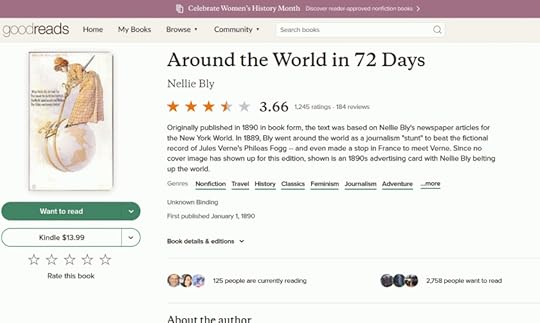 Screenshot of the book posting on Goodreads
Screenshot of the book posting on GoodreadsAs a journalist and writer ahead of her time, and an amazing adventurer, Nellie Bly continues to be an inspiration to all writers, travellers and people who passionately support human rights.



